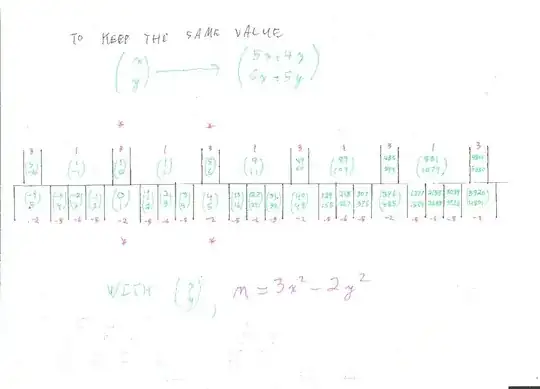I want to generate the recurrence relation for the integer solution of the equation 3m² - 2n² = 1 ; I'm a tenth grader, and so it took me pretty long to at first get out of the normal Quadratic Formula and stuff and realize that there exists things like Cayley-Hamilton Theorem, but unfortunately, I'm inexperienced enough to even try that !! I used Diophantine solving methods, manipulating it but end up messing with the equation ... With reference to Ryan's Generating Integer solution from Hyperbolic Equation , I'd appreciate if one can explain Will Jagy's solution and how he arrived at the recurrence xn+2 = 6xn+1 - xn
-
Someone asked one of these yesterday. Where is the question coming from? – Will Jagy Apr 02 '18 at 17:47
2 Answers
The equation is the same as $$(3m)^2-6n^2=3$$ which in effect is the same as $$r^2-6n^2=3$$ as each solution of this has $3\mid r$. That's the same as $$(r+n\sqrt6)(r-n\sqrt6)=3.$$ Now $$(5+2\sqrt6)(5-2\sqrt6)=1.$$ If $$r'+n'\sqrt6=(5+2\sqrt6)(r+n\sqrt6)$$ then $$r'-n'\sqrt6=(5-2\sqrt6)(r-n\sqrt6)$$ which leads to $$r'^2-6n'^2=(r'+n'\sqrt6)(r'-n'\sqrt6)=(5+2\sqrt6)(r+n\sqrt6) (5-2\sqrt6)(r-n\sqrt6)=3.$$
Then $r'=5r+12n$ and $n'=2r+5n$. If we let $m'=r'/3=5m+4n$ then $n'=6m+5n$ and $$3m'^2-2n'^2=1.$$ So we can start with $(m_0,n_0)=(1,1)$ and then recursively define $$(m_{k+1},n_{k+1})=(5m_k+4n_k,6m_k+5n_k).$$ Then $$m_{k+2}=5m_{k+1}+4n_{k+1}=5m_{k+1}+24m_k+20n_k=10m_{k+1}-m_k$$ and similarly for $n_k$.
- 158,341
I would expect you to do better with Conway's topograph method. Everything involved here can be done without actual matrices, including the recursion. I guess I will put some books, including a very good new one, CONWAY and HATCHER. There is also (I bought a copy) a well illustrated new one by WEISSMAN
This time it is $$ x_{n+2} = 10 x_{n+1} - x_n \; \; , $$ $$ y_{n+2} = 10 y_{n+1} - y_n \; \; . $$
These come from the combined one-step rule $$ (x_{n+1}, y_{n+1}) = (5 x_n + 4 y_n \; , \; 6 x_n + 5 y_n) $$ which you get pretty quickly with Conway. Here is a fairly basic version of the topograph for $3x^2 - 2 y^2,$ showing several locations with $3 x^2 - y^2 = 1$ labelled with the appropriate $\left( \begin{array}{c} x \\ y \end{array} \right)$ in green
Then the separation into two rules can be done without matrices, I wrote that out at http://math.stackexchange.com/questions/1786760/recursive-system-solution/1786850#1786850
Mon Apr 2 10:34:50 PDT 2018
x: 1 y: 1
x: 9 y: 11
x: 89 y: 109
x: 881 y: 1079
x: 8721 y: 10681
Mon Apr 2 10:34:53 PDT 2018
- 139,541
-
Perhaps !! That's where I'm stuck :( How do you derive the recurrence relation at the first place ? – Ansh 2906 Apr 02 '18 at 17:48
